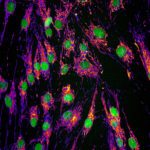Lien vers Pubmed [PMID] – 38866638
Lien DOI – 10.1016/j.tem.2024.05.005
Trends Endocrinol Metab 2024 Oct; 35(10): 854-871
Mitochondria are double membrane-bound organelles the network morphology of which in cells is shaped by opposing events of fusion and fission executed by dynamin-like GTPases. Mutations in these genes can perturb the form and functions of mitochondria in cell and animal models of mitochondrial diseases. An expanding array of chemical, mechanical, and genetic stressors can converge on mitochondrial-shaping proteins and disrupt mitochondrial morphology. In recent years, studies aimed at disentangling the multiple roles of mitochondrial-shaping proteins beyond fission or fusion have provided insights into the homeostatic relevance of mitochondrial morphology. Here, I review the pleiotropy of mitochondrial fusion and fission proteins with the aim of understanding whether mitochondrial morphology is important for cell and tissue physiology.

